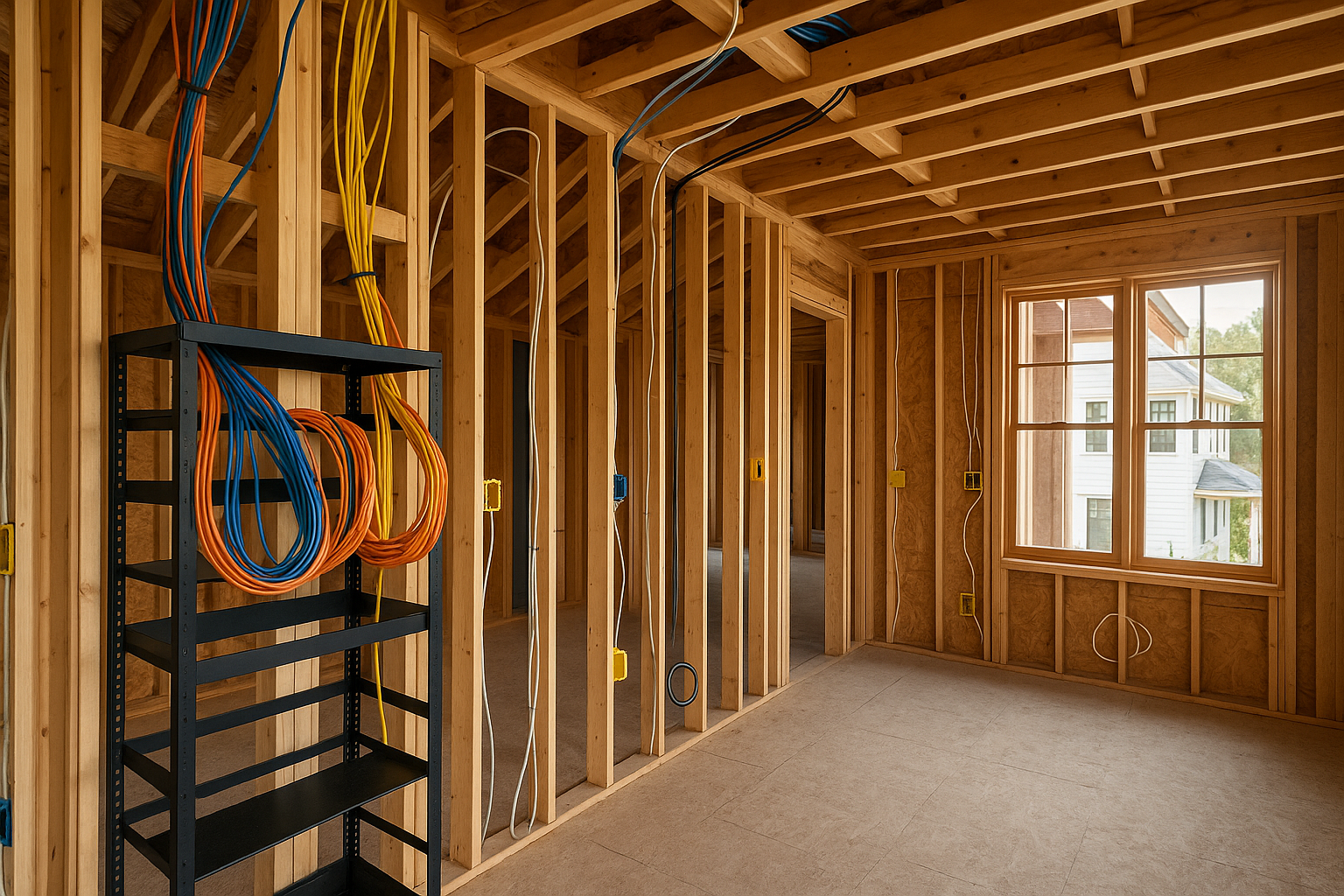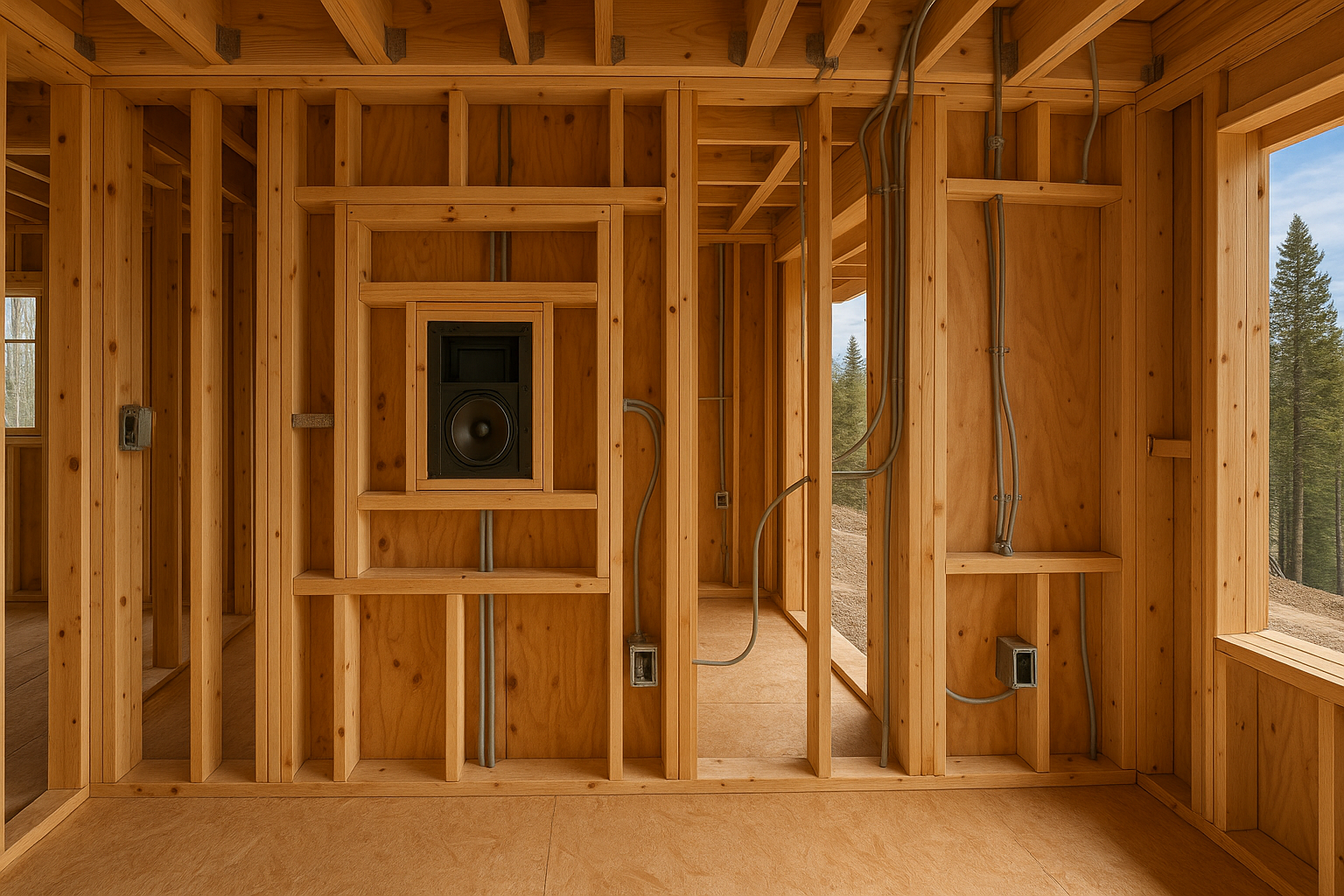Let me just say it:
I used to skip the AV guy.
Not because I didn’t value what they do. But in the frenzy of invoices, ductwork subtleties, foundation waterproofing, and chasing down custom fixtures from Italy that are already delayed eight weeks—well—audio and video didn’t exactly scream “urgent” at the time.
You don’t chase a hidden subwoofer lead like you chase a load of steel beams that’s holding up the rest of your crane schedule.
And so, a couple years back on a dream mountain home, I made what I later came to call “The $40,000 Uh-Oh.”
Let’s rewind.
—
Framing’s Done. Everyone Feels Good.
The bones of the house looked beautiful. Big open floorplans, lots of engineered beamwork, tons of glass. Architect crushed it. Homeowner was thrilled.
I’d just walked a few suites with the electrical contractor—receptacle placement, switch groupings, standard stuff.
Then Xssentials walked into the site trailer.
Timing wasn’t bad. Wiring hadn’t been fully run yet.
But it wasn’t great.
Because their rep opened the set of plans and asked a question I should have answered two months prior:
“So—where’s the AV rack landing?”
Cue silence.
We didn’t have a tech closet. The design hadn’t made room. And it’s not a good look to redefine core infrastructure planning after drywall’s next on the calendar.
—
What I Didn’t Know—But Do Now
At the time, I didn’t realize how complex high-end AV systems have become—especially in mountain homes with a mix of concrete core basements, timber-frame roof structures, and custom steel-framed window walls.
I also didn’t realize how many miles of wire snake through these clients’ homes for distributed audio, hidden TVs, Lutron shades, lighting control, touchpanels, cameras… and how that infrastructure had to be planned precisely—not guessed at.
And if you miss it early?
Back-charging drywall subs for rework. Re-designing cabinetry mid-production. Cringe calls to an interior designer about a thermostat location getting hijacked by an AV controller. You name it.
—
### What Saved Us Was the Conversation We Should’ve Had Sooner
We lucked out.
Xssentials didn’t panic, didn’t grandstand, wasn’t there to say “told you so.” They asked the right questions, calmly found three option paths we could take, and gave me clarity on the cost, operational impact, and timeline effects of each.
That level-headed input bought us time—barely. We found a location for the rack, reworked one wall cavity, and kept the job mostly on track. But it was close.
That project—and others since—was the moment I started pulling AV integration into kickoff phase planning, not pre-finish scramble.
Here’s what I learned from stepping in it once so you don’t have to.
—
Prewire Might Not Be Sexy, But It’s the Pipeline to Smart Luxury
Let’s play this straight.
No homeowner is excited about a prewire proposal.
Wires don’t photograph well in your Instagram “Build Update Week 3” post. They don’t sparkle like a slab waterfall countertop or cozy up a powder room like custom wallcovering.
But those wires are the digital skeleton of the entire home experience your client expects.
And today, AV is not the bonus feature it used to be. According to CE Pro’s 2023 homebuilder survey, 91% of builds over $1 million include structured wiring infrastructure and smart-home prep.
Luxury buyers no longer see whole-house automation, lighting control, or immersive entertainment as upgrades. They’re baseline expectations.
And it all hinges on proper prewire.
—
What Does Prewiring Actually Solve?
Glad you asked. This is what we run into at Xssentials all the time—working alongside great architects and builders who appreciate visibility and want to get ahead of problems, not behind them.
Prewire solves for:
- Coverage: Ensuring you can control shades, speakers, lighting, and screens in every room *without* drilling after finish work
- Power & Pathing: Knowing exactly where media cabinets, TVs, or in-wall speakers draw power, signal, and junction
- Rack Location Planning: Defining where all components (network, processors, amplifiers) live without design disruption
- Cable Management: Future-proofing—labeling, mapping, and routing with changes in mind
- Environmental Readiness: Integrating for altitude sensitivity, freeze-thaw impact, varietal construction materials, and seasonal access (especially crucial for late-stage ski home projects)
—
“What’s the Worst That Could Happen?”
Here in Colorado’s high country, asking that question usually invites drama.
We’ve had more than one scenario where last-minute AV improvisation on expensive wood-paneled ceilings led to repainting or refabrication.
We’ve walked into steel-framed living rooms with zero planned TV mounting support.
We’ve paused theater installs because no conduit was run for low-voltage lighting or surround sound, jeopardizing that custom millwork timeline.
In every one of those cases, someone’s fighting for emergency workarounds at a time when the space should be evolving into its highlight moment.
—
A Note to the Trades
We get it. You’re managing dozens of stakeholders across design phases.
But if we can get one message across, it’s this:
AV prewire should never be viewed as a courtesy walkthrough near the finish line.
It’s infrastructure. Just like plumbing. Just like HVAC. It has structural and architectural consequences if ignored.
Which is why we *love* working with trade partners who bring us in right after mechanical starts.
It’s faster, cleaner, and cheaper when we’re talking slopes, keystones, switch placement, and TV sightlines *before* there’s insulation in a wall.
—
Builders, Avoid My Mistake: Pull AV In Early
Here’s a quick cheat sheet for when and how to loop us in without slowing down your build or drowning the client in tech talk.
Bring us in:
– During *early mechanical layout*, not after
– When rooms are getting pinned for purpose (e.g., “this room might be a media room…”)
– When power circuiting is being plotted
– Before cabinetry is finalized (especially in biophilic or minimalist designs)
We’ll bring:
– Clear AV options with infrastructure impact explained
– Experience with high-altitude impacts on electronics
– Real-world solutions that protect the aesthetic vision
– Wiring diagrams matched to both scope and build phase
– Coordination with HVAC locations, plumbing runs, and thermal envelope requirements
—
Real Talk from the Trenches: What Prewire Costs vs. What Overtime Costs
On average, a strong AV prewire package on a custom luxury home represents about **3-5% of your total AV integration investment**.
As builds go upscale—and automation, lighting, and audio systems layer on—this number rarely rises disproportionately.
Compare that to one holistic rewire request during framing lockdown. We’ve seen those cost 3x, both in time and material, not to mention stress.
Builder tip: prewires are easiest to sell to clients when presented as insurance: “We’re placing the wiring now, so you won’t be locked into clunky wires or unreliable setups later should you expand your smart home footprint.”
(And if they never go beyond the basics, the wire quietly stays tucked away. But if they ever want more? They’ll thank you.)
—
Designers: Integration Starts Way Before Wall Color
Parting thought for interior designers reading this:
We’ve all experienced it—the perfect mirror, fixture, or sconce that gets removed because some device wiring behind it was an afterthought.
That’s what prewiring also protects—**clean surfaces, uninterrupted design language**, and the flexibility to hide technology so it serves space, not crowds it.
When we collaborate early, we can coordinate invisible speaker placement, backbox planning, recessed screen designs, and flush wall control layouts—**before** they become value-engineered casualties.
—
Feeling Like Redemption Yet?
If you’re a builder, designer or architect who’s ever had that sinking feeling when the tech guys show up *after* the site is humming, I’ll leave you with this:
You’re not alone. I’ve been there.
But you can tighten your workflow. You *can* be the hero who remembered to make space for everything from a network rack to fiber-level prewire.
And here’s the kicker: That collaboration gets noticed by clients. It makes you look even more buttoned-up and savvy.
Because while AV prewire doesn’t sell the dream—it protects it.
And when it protects the dream, it becomes the best kind of sexy: quietly critical.
—
Ready for the next build? Let’s walk it together before the concrete cures.
Because no one brags about the wire runs—until they dodge a six-figure mistake.



